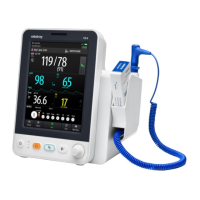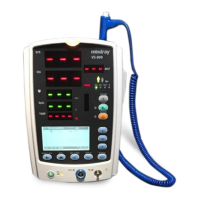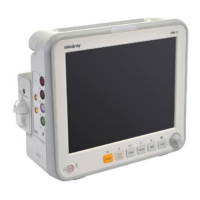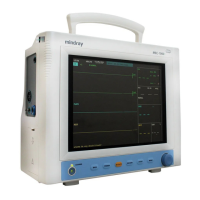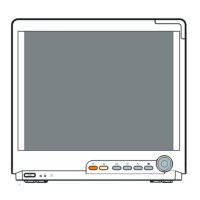15-2
15.2 Charging a Battery
The battery is charged whenever the monitor is connected to an AC power source
regardless of whether or not the monitor is currently on. When battery is charging, the AC
power indicator and battery indicator are both On. The battery status symbol on the
monitor screen displays when the charging is complete.
15.3 Replacing a Battery
1. Power off the monitor.
2. Open the battery compartment door.
3. Push aside the latch fixing the battery to be replaced and remove the battery.
4. Place a new battery into the slot with its contact point inward.
5. Close the battery compartment door.
15.4 Battery Guidelines
Life expectancy of a battery depends on how frequent and how long it is used. For a
properly maintained and stored lithium ion battery, its life expectancy is about 3 years.
For more aggressive use models, life expectancy can be less. We recommend replacing
lithium ion batteries every 3 years.
To get the most out of the battery, observe the following guidelines:
The battery performance test must be performed once a year, before monitor
repairs, or whenever the battery is suspected as being the source of the
problems.
Condition the batteries once when they are used or stored for three months, or
when their run time becomes noticeably shorter.
Take out the battery before the monitor is transported or will not be used for
more than 3 months.
Remove the battery from the monitor if it is not being used regularly. (Leaving
the battery in a monitor that is not in regular use will shorten the life of the
battery).
The shelf life of a Lithium Ion battery is about 6 months when the battery is
stored with the battery power being 50% of the total power. In 6 months the
battery power must be depleted before the Lithium Ion battery is fully charged.
Then run the monitor on this fully charged battery .When its battery power
becomes 50% of the total power, take out the battery from the monitor and
store it.
When storing batteries, make sure that the battery terminals do not come into
contact with metallic objects. If batteries are stored for an extended period of
time, they should be placed in a cool place with a partial charge of 40% to 60%
capacity. Storing batteries at high temperature for an extended period of time
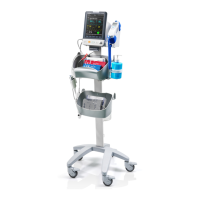
